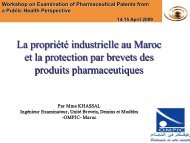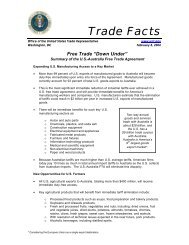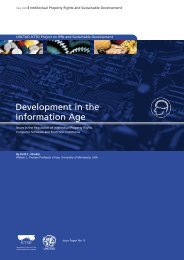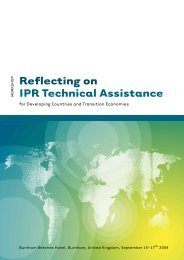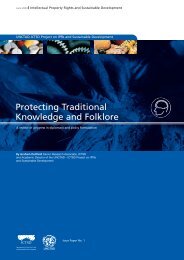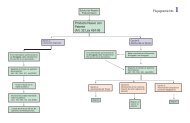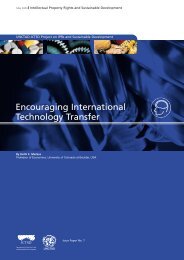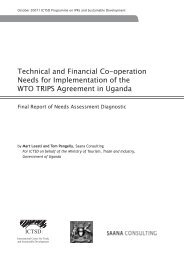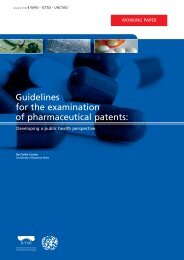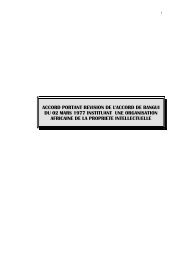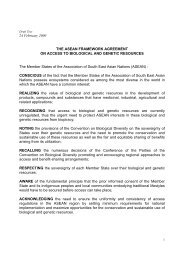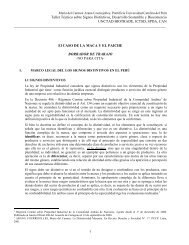Governance and Micropolitics of Traditional ... - IPRsonline.org
Governance and Micropolitics of Traditional ... - IPRsonline.org
Governance and Micropolitics of Traditional ... - IPRsonline.org
You also want an ePaper? Increase the reach of your titles
YUMPU automatically turns print PDFs into web optimized ePapers that Google loves.
Hamilton provides a good summary <strong>of</strong> the way biological materials in agriculture were<br />
treated some 50 years ago, prior to developments in biotechnology <strong>and</strong> subsequent<br />
strengthening <strong>and</strong> ‘harmonisation’ <strong>of</strong> intellectual property rights:<br />
There was no distinction between tangible <strong>and</strong> intellectual property, <strong>and</strong> you owned what you<br />
bought or bartered or produced or were given.<br />
Farmers were breeders. They produced new genotypes by combining old ones from various<br />
sources – the market place, their own fields, their neighbours, or, ultimately, wild species;<br />
<strong>and</strong> they selected, grew <strong>and</strong> marketed the best genotypes.<br />
When farmers sold seed to neighbouring farmers or in the market place, they sold at the best<br />
market price <strong>and</strong> sold the seed along with all rights to use the seed. If the neighbour used<br />
their seed to breed an even better genotype <strong>and</strong> make more pr<strong>of</strong>it, they didn't claim a share <strong>of</strong><br />
the neighbour's pr<strong>of</strong>it.<br />
Living things that had not been bought, bartered or produced by people – i.e. all wildlife,<br />
animals <strong>and</strong> plants <strong>and</strong> microbes – were not considered the property <strong>of</strong> anyone.<br />
The result: unrestricted germplasm exchange, hybridization <strong>and</strong> selection, with literally<br />
millions <strong>of</strong> “breeders” each selecting for adaptation to a different environment <strong>and</strong> with<br />
different perceptions <strong>of</strong> the kind <strong>of</strong> product they wanted. This generated an unprecedented<br />
incredible new range <strong>of</strong> domesticated biodiversity. Genetic variation within species <strong>of</strong><br />
domesticated plants <strong>and</strong> animals far exceeds that within wild species. The enormous range <strong>of</strong><br />
domesticated biodiversity is part <strong>of</strong> what stunned Charles Darwin into working out his theory<br />
<strong>of</strong> evolution. Hamilton, R.S. (IRRI Website, Acc 17/6/2005)<br />
Effectively farmers researched, developed <strong>and</strong> domesticated a diverse array <strong>of</strong> plant varieties<br />
that contained a vast range <strong>of</strong> genetic variation. Seeds were shared with friends <strong>and</strong> other<br />
farmers in the interest <strong>of</strong> developing more varieties <strong>and</strong> in the hope <strong>of</strong> finding new<br />
adaptations to environmental conditions that may produce higher yields or better quality<br />
grains. Scientists <strong>and</strong> western plant breeders recognised this <strong>and</strong> sought to collect as much <strong>of</strong><br />
this crop germplasm with the intent <strong>of</strong> developing such varieties using modern technologies.<br />
Not only did they find agricultural varieties with unique <strong>and</strong> important qualities for plant<br />
breeding, they also gathered herbs <strong>and</strong> wild plants with medicinal qualities from community<br />
healers <strong>and</strong> shamans, realising the potential these could have in modern pharmaceuticals or<br />
cosmetics.<br />
During the late 1960s, through the 1970s advances in plant breeding saw the development <strong>of</strong> a<br />
range <strong>of</strong> new advanced varieties including hybrids or ‘high yielding varieties’ (HYVs). These<br />
varieties were widely promoted by the Food <strong>and</strong> Agriculture Organisation (FAO) <strong>and</strong><br />
Consultative Group on International Agricultural Research (CGIAR) Institutes to achieve a<br />
higher agricultural productive output to feed an ever exp<strong>and</strong>ing global population <strong>and</strong> assist in<br />
the reduction <strong>of</strong> existing hunger. Furthermore these were promoted by the Bretton Woods<br />
Institutes as part <strong>of</strong> finance, aid <strong>and</strong> development packages. It was widely perceived that the<br />
only way to achieve goals <strong>of</strong> hunger <strong>and</strong> malnutrition reduction was through new agricultural<br />
technologies that increased yield, <strong>and</strong> were supposed to supplement deficient vitamin or<br />
calorie intake that is associated with malnutrition <strong>and</strong> an array <strong>of</strong> diseases. Since that time<br />
many activists <strong>and</strong> academics have been critical <strong>of</strong> the way agriculture became rapidly<br />
7




